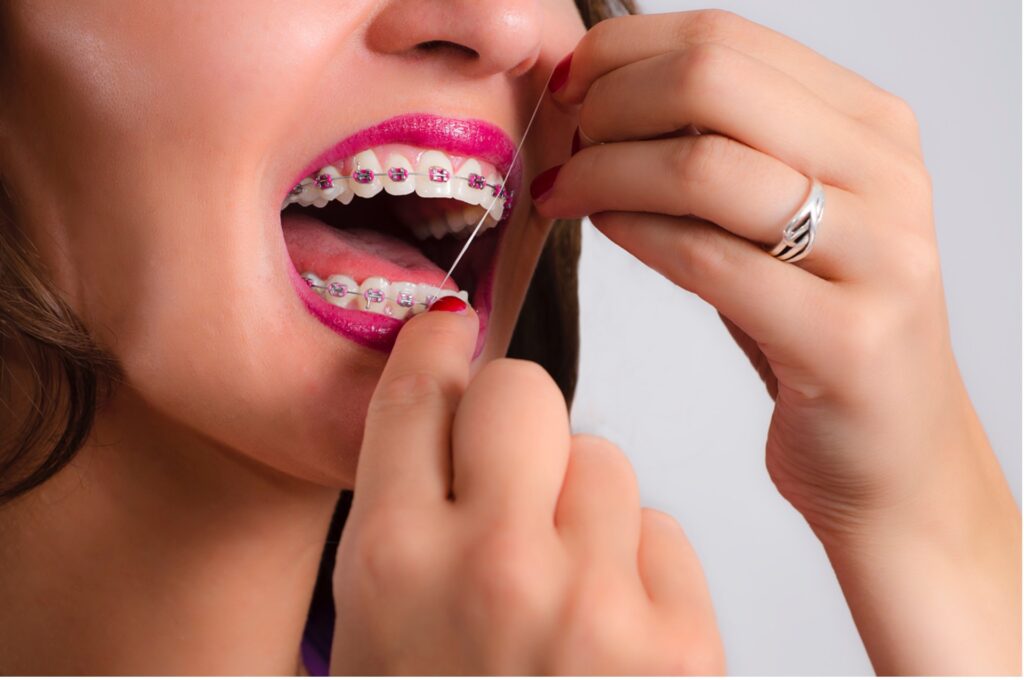Flossing with braces can be tricky. That moment when the floss gets stuck can be quite a puzzle. But no worries! Our guide has the techniques and vital tips for when the floss decides to camp out in your braces. We’ll guide you on how to maintain a carefree flossing routine.
Why Flossing Matters with Braces
Proper oral hygiene is essential when you have braces. With braces, there are more spots where food particles and plaque can gather, increasing the risk of tooth decay, gum disease, and bad breath. Regular flossing removes food from between the teeth and around the braces, preventing these issues. Neglecting flossing can lead to stains on your teeth and early decay signs. So, proper flossing is essential for keeping teeth healthy and preserving their appearance during orthodontic treatment.
Challenges of Flossing
The wires, brackets, and bands make flossing challenging with braces. Regular flossing techniques need help to reach around these parts, making oral hygiene difficult. These spaces between wires and brackets can trap food particles and plaque, making cleaning difficult. The risk of floss getting stuck in braces is a common frustration during orthodontic treatment. However, understanding these challenges is the first step towards finding practical solutions and building a flossing routine that suits your needs.
Tools for Flossing with Braces
Thankfully, there are tools that can make flossing with braces much simpler.
- Floss Threaders help thread regular floss under the archwires, allowing easy movement between teeth and around the braces.
- Orthodontic flossers, a pre-threaded flossing tool, are designed specifically for individuals with braces. Their angled necks make it easier to access hard-to-reach spots around the braces.
- Interdental brushes can also help clean between teeth and around braces. They reach areas traditional floss might struggle with, adding to your oral care routine’s effectiveness.
- Water Flossers use a targeted stream to clean between teeth and braces.
A Step-by-Step Guide
Flossing with braces requires a different approach. Here’s a step-by-step guide:
- Prepare Your Floss: Cut an 18-inch piece of floss.
- Thread the Floss: Use a floss threader if needed.
- Clean Between Each Tooth: Gently guide your floss around the braces, moving from tooth to tooth.
- Switch to Clean Sections: Unwind a fresh floss section for each tooth.
- Rinse and Inspect: Check for any remaining debris in the mirror after flossing.
What to Do When Floss Gets Stuck
- Remain Calm: Avoid pulling forcefully.
- Use a Floss Threader: Carefully navigate the floss to release it.
- Gently Wiggle the Floss: Ease it out between teeth.
- Seek Professional Assistance: Ask your orthodontist or dentist for help if needed.
Dos and Don’ts for Keeping Your Teeth in Top Shape While Wearing Braces
- Be gentle. Do not use excessive force.
- Clean thoroughly around braces and all areas of your teeth. Do not neglect the hard-to-reach areas.
- Make brushing and flossing a daily habit. Do not skip out on them.
- Keep your dental and orthodontic appointments.
For more tips, see our website page: Life with Braces
In conclusion, flossing with braces may present challenges, but keeping your oral hygiene during treatment becomes manageable with the right tools, techniques, and professional care. Prioritize consistent and effective flossing to support the health and success of your orthodontic journey. Please contact us if you need to schedule a consultation with Dr. Erickson.
Your Friendly Team



